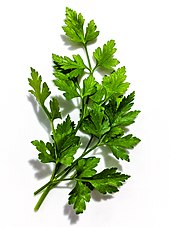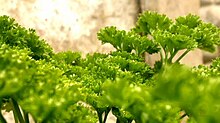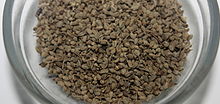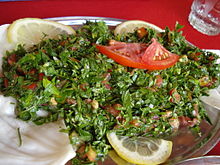Parsley, or garden parsley (Petroselinum crispum) is a species of flowering plant in the family Apiaceae that is native to Greece, Morocco and the former Yugoslavia.[1] It has been introduced and naturalized in Europe and elsewhere in the world with suitable climates, and is widely cultivated as a herb, and a vegetable.
It is believed to have been originally grown in Sardinia and was cultivated in around the 3rd century BC. Linnaeus stated its wild habitat to be Sardinia, whence it was brought to England and apparently first cultivated in Britain in 1548,[citation needed] though literary evidence suggests parsley was used in England in the Middle Ages, as early as the Anglo-Saxon period.[2]
Parsley is widely used in European, Middle Eastern, and American cuisine. Curly-leaf parsley is often used as a garnish. In central Europe, eastern Europe, and southern Europe, as well as in western Asia, many dishes are served with fresh green chopped parsley sprinkled on top. Flat-leaf parsley is similar, but is often preferred by chefs because it has a stronger flavor.[3] Root parsley is very common in central, eastern, and southern European cuisines, where it is used as a snack or a vegetable in many soups, stews, and casseroles.
Etymology

The word "parsley" is a merger of Old English petersilie (which is identical to the contemporary German word for parsley: Petersilie) and the Old French peresil. Both of these names are derived from Medieval Latin petrosilium, from Latin petroselinum, which is the latinization of the Greek πετροσέλινον, petroselinon, 'rock-celery',[4][5] from πέτρα, petra, 'rock, stone'[6] and σέλινον, selinon, 'celery'.[7][8][9] Mycenaean Greek se-ri-no, in Linear B, is the earliest attested form of the word selinon.[10]
Description

Garden parsley is a bright green, biennial plant in temperate climates, or an annual herb in subtropical and tropical areas.
Where it grows as a biennial, in the first year, it forms a rosette of tripinnate leaves 10–25 cm long with numerous 1–3 cm leaflets, and a taproot used as a food store over the winter. In the second year, it grows a flowering stem to 75 cm (30 in) tall with sparser leaves and flat-topped 3–10 cm diameter umbels with numerous 2 mm diameter yellow to yellowish-green flowers.[9][11][12]
The seeds are ovoid, 2–3 mm long, with prominent style remnants at the apex. One of the compounds of the essential oil is apiole. The plant normally dies after seed maturation.[9][11][12]
Uses
Culinary
Parsley is widely used in Middle Eastern, Mediterranean, Brazilian, and American cuisine. Curly leaf parsley is used often as a garnish. Green parsley is used frequently as a garnish on potato dishes (boiled or mashed potatoes), on rice dishes (risotto or pilaf), on fish, fried chicken, lamb, goose, and steaks, as well as in meat or vegetable stews (including shrimp creole, beef bourguignon, goulash, or chicken paprikash).[13]

Parsley seeds are also used in cooking, imparting a stronger parsley flavor than leaves.[14][citation needed]
Parsley, when consumed, is accredited with neutralising odours associated with garlic in cooking.[15]
In central Europe, eastern Europe, and southern Europe, as well as in western Asia, many dishes are served with fresh green, chopped parsley sprinkled on top. In southern and central Europe, parsley is part of bouquet garni, a bundle of fresh herbs used as an ingredient in stocks, soups, and sauces. Freshly chopped green parsley is used as a topping for soups such as chicken soup, green salads, or salads such as salade Olivier, and on open sandwiches with cold cuts or pâtés.
Persillade is a mixture of chopped garlic and chopped parsley in French cuisine.
Parsley is the main ingredient in Italian salsa verde, which is a mixed condiment of parsley, capers, anchovies, garlic, and sometimes bread, soaked in vinegar. It is an Italian custom to serve it with bollito misto or fish. Gremolata, a mixture of parsley, garlic, and lemon zest, is a traditional accompaniment to the Italian veal stew, ossobuco alla milanese.
In England, parsley sauce is a roux-based sauce, commonly served over fish or gammon. It is also served with pie and mash in the East End of London, and in fact all over London and The Home Counties, where it is referred to as Liquor.[original research?]
Root parsley is very common in Central, Eastern, and Southern European cuisines, where it is used as a snack or a vegetable in many soups, stews, and casseroles, and as ingredient for broth.

In Brazil, freshly chopped parsley (salsa) and freshly chopped scallion (cebolinha) are the main ingredients in the herb seasoning called cheiro-verde (literally "green aroma"), which is used as key seasoning for major Brazilian dishes, including meat, chicken, fish, rice, beans, stews, soups, vegetables, salads, condiments, sauces, and stocks. Cheiro-verde is sold in food markets as a bundle of both types of fresh herbs. In some Brazilian regions, chopped parsley may be replaced by chopped coriander (also called cilantro, coentro in Portuguese) in the mixture.
Parsley is a key ingredient in several Middle Eastern salads such as Lebanese tabbouleh; it is also often mixed in with the chickpeas and/or fava beans while making falafel (that gives the inside of the falafel its green color). It is also a main component of the Iranian stew ghormeh sabzi.
Parsley is a component of a standard Seder plate arrangement, it is eaten to symbolize the flourishing of the Jews after first arriving in Egypt.[16]
Composition
Nutritional content
Parsley is a source of flavonoids and antioxidants, especially luteolin, apigenin,[19] folate, vitamin K, vitamin C, and vitamin A. Half a tablespoon (a gram) of dried parsley contains about 6.0 μg of lycopene and 10.7 μg of alpha carotene as well as 82.9 μg of lutein+zeaxanthin and 80.7 μg of beta carotene.[20] Dried parsley can contain about 45 mg/gram apigenin.[21] The apigenin content of fresh parsley is reportedly 215.5 mg/100 grams, which is much higher than the next highest food source, green celery hearts providing 19.1 mg/100 grams.[22] Parsley essential oil is high in myristicin.[23]
Precautions
Excessive consumption of parsley should be avoided by pregnant women. Normal food quantities are safe for pregnant women, but consuming excessively large amounts may have uterotonic effects.[24]
Cultivation
Parsley grows best in moist, well-drained soil, with full sun. It grows best between 22–30 °C (72–86 °F), and usually is grown from seed.[12] Germination is slow, taking four to six weeks,[12] and it often is difficult because of furanocoumarins in its seed coat.[25] Typically, plants grown for the leaf crop are spaced 10 cm apart, while those grown as a root crop are spaced 20 cm apart to allow for the root development.[12]
Parsley attracts several species of wildlife. Some swallowtail butterflies use parsley as a host plant for their larvae;[26] their caterpillars are black and green striped with yellow dots, and will feed on parsley for two weeks before turning into butterflies. Bees and other nectar-feeding insects also visit the flowers.
Cultivars

In cultivation, parsley is subdivided into several cultivar groups,[27] depending on the form of the plant, which is related to its end use. Often these are treated as botanical varieties,[28] but they are cultivated selections, not of natural botanical origin.[11]
Leaf parsley
The two main groups of parsley used as herbs are French, or curly leaf (P. crispum Crispum Group; syn. P. crispum var. crispum); and, Italian, or flat leaf (P. crispum Neapolitanum Group; syn. P. crispum var. neapolitanum).[29] Flat-leaved parsley is preferred by some gardeners as it is easier to cultivate, being more tolerant of both rain and sunshine,[30] and is said to have a stronger flavor[12]—although this is disputed[30]—while curly leaf parsley is preferred by others because of its more decorative appearance in garnishing.[30][31] A third type, sometimes grown in southern Italy, has thick leaf stems resembling celery.[30]
Root parsley

Another type of parsley is grown as a root vegetable, the Hamburg root parsley (P. crispum Radicosum Group, syn. P. crispum var. tuberosum). This type of parsley produces much thicker roots than types cultivated for their leaves. Although seldom used in Britain and the United States, root parsley is common in central and eastern European cuisine, where it is used in soups and stews, or simply eaten raw, as a snack (similar to carrots).[30]
Although root parsley looks similar to the parsnip, which is among its closest relatives in the family Apiaceae, its taste is quite different.[32]
Gallery
-
Freeze-dried parsley showing name in German, Spanish and Greek on the label
-
Flat-leaved parsley
-
Flat-leaved parsley flower
-
Immature seeds
-
Flat-leaved parsley flower-Flor de perejil
-
Bee pollinator on parsley Petroselinum crispum flower
See also
- Apium virus Y
- List of culinary herbs and spices
- List of plants with edible leaves
- List of vegetables
- Oenanthe javanica
- Cryptotaenia japonica
References
- ^ a b "Petroselinum crispum (Mill.) Fuss". Plants of the World Online. Royal Botanic Gardens, Kew. Retrieved 1 March 2023.
- ^ "More on Parsley". Monk's Modern Medieval Cuisine. 26 October 2020. Retrieved 24 January 2022.
- ^ "Parsley: More Than a Garnish | Illinois Extension | UIUC". extension.illinois.edu. 2019-05-08. Retrieved 2024-01-25.
- ^ Lewis, Charlton T.; Short, Charles (1879). "petrŏsĕlīnon (-īnum )". A Latin Dictionary. Perseus Digital Library.
- ^ Liddell, Henry George; Scott, Robert (1940). "πετροσέλινον". A Greek-English Lexicon. Perseus Digital Library.
- ^ Liddell, Henry George; Scott, Robert (1940). "πέτρα". A Greek-English Lexicon. Perseus Digital Library.
- ^ Liddell, Henry George; Scott, Robert (1940). "σέλινον". A Greek-English Lexicon. Perseus Digital Library.
- ^ The Euro+Med Plantbase Project: Petroselinum crispum Archived 2012-03-09 at the Wayback Machine
- ^ a b c Interactive Flora of NW Europe: [1]
- ^ "Palaeolexicon". Palaeolexicon. Archived from the original on 13 April 2016. Retrieved 23 July 2018.
- ^ a b c Blamey, M.; Grey-Wilson, C. (1989). Illustrated Flora of Britain and Northern Europe. Hodder & Stoughton. ISBN 0-340-40170-2.
- ^ a b c d e f Huxley, A., ed. (1992). New RHS Dictionary of Gardening. Vol. 3. Macmillan. p. 532. ISBN 0-333-47494-5.
- ^ Meyer, J. (1998). Authentic Hungarian Heirloom Recipes Cookbook (2nd ed.). Meyer & Assoc. ISBN 0-9665062-0-0.
- ^ "Parsley: More Than a Garnish". 30 July 2016.
- ^ "The Martha Stewart method: How to easily remove garlic smell". TOI. 14 March 2024. Retrieved 21 May 2024.
- ^ "The Seder Plate". My Jewish Learning. Retrieved 2023-02-08.
- ^ United States Food and Drug Administration (2024). "Daily Value on the Nutrition and Supplement Facts Labels". FDA. Archived from the original on 2024-03-27. Retrieved 2024-03-28.
- ^ National Academies of Sciences, Engineering, and Medicine; Health and Medicine Division; Food and Nutrition Board; Committee to Review the Dietary Reference Intakes for Sodium and Potassium (2019). Oria, Maria; Harrison, Meghan; Stallings, Virginia A. (eds.). Dietary Reference Intakes for Sodium and Potassium. The National Academies Collection: Reports funded by National Institutes of Health. Washington, DC: National Academies Press (US). ISBN 978-0-309-48834-1. PMID 30844154. Archived from the original on 2024-05-09. Retrieved 2024-06-21.
- ^ Meyer, H.; Bolarinwa, A.; Wolfram, G. & Linseisen, J. (2006). "Bioavailability of apigenin from apiin-rich parsley in humans" (PDF). Annals of Nutrition and Metabolism. 50 (3): 167–172. doi:10.1159/000090736. PMID 16407641. S2CID 8223136.
- ^ "Spices, parsley, dried Nutrition Facts & Calories". nutritiondata.self.com. Retrieved 2023-02-08.
- ^ Shankar E, Goel A, Gupta K, Gupta S (2017). "Plant flavone apigenin: An emerging anticancer agent". Current Pharmacology Reports. 3 (6): 423–446. doi:10.1007/s40495-017-0113-2. PMC 5791748. PMID 29399439.
- ^ Delage, PhD, Barbara (November 2015). "Flavonoids". Linus Pauling Institute, Oregon State University, Corvallis, Oregon. Retrieved 2021-01-26.
- ^ Marín I, Sayas-Barberá E, Viuda-Martos M, Navarro C, Sendra E. Chemical Composition, Antioxidant and Antimicrobial Activity of Essential Oils from Organic Fennel, Parsley, and Lavender from Spain. Foods. 2016;5(1):18. Published 2016 Mar 4. doi:10.3390/foods5010018
- ^ "Parsley Uses, Benefits & Side Effects - Drugs.com Herbal Database". Drugs.com.
- ^ Jett, J. W. That Devilish Parsley Archived 2007-06-26 at the Wayback Machine West Virginia University Extension Service. Last retrieved April 26, 2007.
- ^ Jackman, John A.; Drees, Bastiaan M. (1998-03-01). A Field Guide to Common Texas Insects. Taylor Trade Publishing. ISBN 978-1-4616-2291-8.
- ^ "M.M.P.N.D. - Sorting Petroselinum names". www.plantnames.unimelb.edu.au. Retrieved 2023-02-08.
- ^ "Petroselinum crispum". Germplasm Resources Information Network. Agricultural Research Service, United States Department of Agriculture. Retrieved 10 December 2017.
- ^ Ciju, Roby Jose (2021-03-18). Leaves as Vegetables: Food Significance and Nutritional Information. AgriHortico.
- ^ a b c d e Stobart, T. (1980). The Cook's Encyclopaedia. Macmillan ISBN 0-333-33036-6.
- ^ "How To Grow Parsley". Herb Growing Guide. 20 September 2020. Retrieved 21 September 2020.
- ^ Davidson, Alan (2014-08-21). The Oxford Companion to Food. OUP Oxford. ISBN 978-0-19-104072-6.
- Chisholm, Hugh, ed. (1911). . Encyclopædia Britannica (11th ed.). Cambridge University Press.
External links
 Media related to Petroselinum crispum at Wikimedia Commons
Media related to Petroselinum crispum at Wikimedia Commons Data related to Petroselinum crispum at Wikispecies
Data related to Petroselinum crispum at Wikispecies







Recent Comments